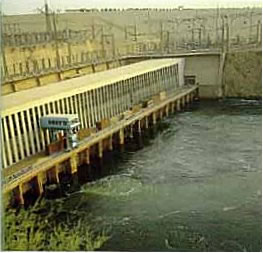The change from basin to perennial irrigation began after 1800 with the building of barrages. These low barriers across the Nile lifted the water for movement through canals to irrigate summer crops downstream. Then in 1902 a dam was built to actually store water for use in the summer. This was the low dam placed at Aswan in southern Egypt. The final conversion to perennial irrigation came with construction of the Aswan High Dam completed in 1970. This two and half mile long dam took more than a decade to build, and it blocks the Nileís journey to the sea. At the time of itís construction it was the largest dam in the world. Itís height was then twice raised again in effort to control the river. The Aswan blocks the Nile's journey to the sea and the river backs up behind the dam forming a 300 mile long reservoir called Lake Nasser. Lake Nasser is one of the largest artificial lakes in the world.
Construction of the dam began in 1960 and cost about $1 billion. The dam began operating in 1968. The Soviet Union provided technical assistance and more than $300 million in loans for the project. The high dam replaced the smaller Aswan Dam, which stands nearby and is used chiefly to generate electricity. (Traveler Egypt 2002) |
